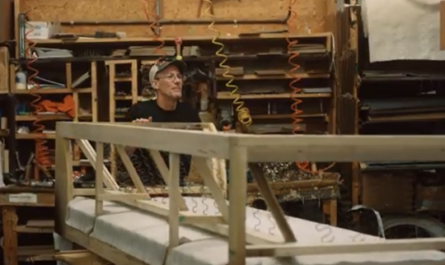The Top 100 retailer is reaching the growing number of cable cord-cutters in its market via streaming networks and cutting its marketing costs in the process
FRANKLIN FURNACE, Ohio — Robert VanHoose jokes that a couple of years ago, he didn’t even know how to spell OTT. But now over-the-top television has become his go-to medium for efficient, targeted advertising to the consumers he most wants to reach.
“I’ve been a traditional media guy all of my life,” VanHoose, CEO of Big Sandy Superstore, told Home News Now. The retailer has been a big buyer of broadcast television spots, and circulars for years. But as VanHoose and his marketing team started learning the ins and outs of Facebook advertising and then streaming television, the retailer’s ad spend has been gradually shifting to OTT and other digital outlets, and the results have greatly exceeded all expectations — even as Big Sandy’s overall advertising budget has shrunk as a percentage of sales.
There’s an old joke VanHoose recalled that goes: “I always knew half of the money I’m spending on marketing I’m wasting. I just don’t know which half.” But now, he actually does know what’s working; he’s seen the proof in the new punchline.

Going on two years now, Big Sandy began working with a company called Octillion Media (in the process of rebranding itself as Octillion). It is not a reseller of ad inventory, but rather a “platform as a service company” that has direct relationships with Hulu and other streaming services. It helps companies navigate digital advertising inventory buys and then monitor their spend and the results seamlessly and transparently. It’s not the only one, but it’s growing fast in the home furnishings industry and that transparency piece appears to have a lot to do with it.
Knowing when they buy
A retailer such as Big Sandy gets full access to a dashboard to see exactly when and where his spots are running and what the media and data costs are. Before Octillion, Big Sandy was dabbling in OTT by buying spots through a local television station. The spots may have been cheaper than what the company pays through Octillion today, but VanHoose said he was often getting exactly what he was paying for: “garbage inventory” that did not translate into sales.
Now he’s getting the better inventory on better streaming networks like Hulu, which doesn’t offer ad time to resellers like that sales department of the local television station. But for VanHoose, the biggest game changer with the Octillian’s platform is in what he called the newly found “power of attribution,” basically the ability to match a viewer of his commercial with an actual purchaser of a Big Sandy sofa, television or refrigerator. By feeding his purchase data to Octillion, Octillion can turn around and find the IP addresses of roughly 80% of those buying customers and enables the retailer to actually match up sales with Big Sandy ad viewers, he said. So while it may be a stretch to say Big Sandy now knows which half of its advertising budget is wasted, as the joke goes, it does have a much better idea now of which half is working.
VanHoose added that he was also drawn to Octillion because of its ability to target “intenders,’ those consumers who may have just changed addresses for instance, or bought a new home or applied for a home equity loan — people likely to be in the market for home furnishings. Other OTT sources say they target intenders, too, but VanHoose and Octillion say transparency is missing for the retailer, or it’s based on aged information. That (along with the dollars you need to move the needle, some say) is the kind of thing that keeps some retailers from making OTT a regular part of their ad budgets.

“Everyone knows they should be digital, but there’s so much hocus pocus,” VanHoose said. “I’ve got my own dashboard. I see exactly what has run. It’s fully transparent.”
“The ability to target people in the market made the buy at least 20-to-one more effective than a network spot,” VanHoose contended. “We’re able to target them way down the funnel and influence their buying decision.”
Gabe Greenberg, CEO and co-founder of Octillion, said his company has a strong foothold in the home furnishings space among others, having developed an exclusive partner relationships with the AVB/Brandsource buying group a couple of years ago as well as with Big Sandy (a BrandSource member) and now the lion’s share of Top 100 home furnishings retailers. All told, Greenberg estimated about 200 furniture bedding and appliance dealers of all sizes are working with the company.

The platform offers three attribution tools. The first is related to foot traffic: It can tell if a consumer exposed to an ad actually ended up visiting the retailer’s store. Another has to do with Web traffic and it’s the same idea: Did the ad-watching consumer end up on the retailer’s website? And finally there’s the sales attribution tool VanHoose mentioned. It can show cases where the consumer who saw a Big Sandy spot ended up making a purchase with the retailer.
And how does it accomplish the latter? For starters, the retailer needs to share its data on purchasing customers. Octillion then converts the postal addresses into digital identifiers that it matches up to other digital identifiers it has for the consumers watching the streaming ads on their connected TVs or other household devices. It’s a one-to-one determination, Greenberg said. Octillion doesn’t do any modeling or probabilistic guessing to match buyers with ad-watchers. If the buyer and the ad watcher are the same, Octillion knows it. The dashboard provides insights along the way, so the ad buyer like Big Sandy can see what is happening with the campaign and attribution in real-time.
Its technology also makes ad purchasing decisions in milliseconds. In about the blink of an eye, the platform is calculating to see if that person watching a program on, say Hulu or Sling, is the market for a new sofa, and it then feeds an ad to that “intender.”
“So you may be watching Peacock or the NBC app in your home, and your neighbor may be watching (the same),” Greenberg said. “You may be in the market for an appliance; your neighbor is not. You may see that Big Sandy ad; your neighbor will not.”
And the technology can dig even deeper, feeding the Big Sandy’s appliance spot only to those consumers in the market for an appliance and feeding a different Big Sandy sofa spot to someone more apt to buy a sofa.
“So we eliminate the waste you have in linear television, allowing you to make that ad more addressable,” Greenberg said. “And we’re able to do it in very near real time, attributing those actions, whether it’s website activity or sales. In Big Sandy’s case, we can tell him not only who is buying, but what they are watching and therefore optimize his media schedule to buy more in those sorts of places where buyers are coming from.”
It also deploys three levels of fraud detection to avoid fraudulent inventory or invalid traffic, Greenberg said, a big deal, he added, considering OTT is still a bit of the Wild West. On some platforms, he contended 15 to 30 cents of every ad dollar is wasted on fraud, working against one of the main goals of OTT advertising. That is, to eliminate the waste inherent in the shotgun approach of most traditional media by targeting messages to only the best prospects.
The shift away from traditional advertising
Over time, the 31-store Big Sandy has gradually shifted more ad dollars to OTT, going from about $50,000 a month when it started two years ago to about $150,000 a month today. It’s still spending roughly 55% of its overall budget on network TV, but VanHoose has dramatically cut back on other traditional media, such as circulars and radio.
Earlier this year, he began paying a little more for OTT to ensure Big Sandy spots showed up on more of the premium networks — Hulu, Sling and the like vs. freebies like Tubi, Crackle and Plex — testing a theory that this is where the better cord-cutting customers were hanging out.
From February through March, before he made the change, VanHoose attributed 4,400 sales to OTT. In April and May, typically a slower period, with the exception of Memorial Day weekend, he paid 17% more for the better OTT slots and was able to match 7,400 sales back to medium.
In another recent experiment, Big Sandy gave Octillion the preferred customer list it uses for direct mail campaigns to see what would happen. Direct mail is one of the rare traditional mediums for which attribution is possible and fairly easy to do, albeit manually. On big holidays, the retailer will spend about $60,000 on direct mail to target that VIP consumer base. This past Memorial Day it spent a bit more to do just that and was able to attribute 22% of its sales to the mail campaign.
VanHoose then sent the same list to Octillion, which was able to identify the IP addresses of roughly 80% to 90% of the VIPs and target them with 30-second spots. Big Sandy spent $3,700 on that campaign (for both OTT and Facebook) and “I got 24% of my sales off that list … at a savings of $56,000,” VanHoose said. He’s only tried that once so far, but wants to repeat it to see if the results hold up.
All told, Big Sandy’s has managed to cut its ad budget in half — to about 2% of sales from the previous 4%, and it’s experiencing record business all the same.
That’s partly, if not mostly, due to the “crazy numbers” the retailer and others have seen ever since consumers emerged from last year’s lockdown, of course. But demand is starting to wane, VanHoose said. Big Sandy is starting to see comp store sales declines of about 10% from last year. Sales are still up about 60% over 2019, but VanHoose said flat comps for the rest of the year should be considered a win. So the kind of return the retailer is seeing from OT advertising is only going to become more important for forward.
“It’s been a game changer to the bottom line and it’s so much more efficient,” he said. “I’m really concentrating on attribution, tweaking and knowing which part is and isn’t working.”
But it’s not for everyone
VanHoose said he believes many in the industry aren’t using OTT either because they don’t understand it or because they’ve been burned by poor-performing campaigns through other platforms or resellers. But there appears to be another possible reason, too: It takes a fairly large investment to make the buy statistically relevant and might be out of the comfort zone for a lot of smaller players with smaller ad budgets. Two percent of sales might sound small, but Big Sandy did about $340 million in total revenues in 2020, so that 2% equates to an ad budget of about $6.8 million, or more than $566,000 a month.
AVB/BrandSource partnered with Octillion about two years ago, and the buying group’s members using the service are seeing higher average tickets and a “pretty strong return on investment as well,” said Dan Evans, product manager, OTT advertising for AVB Marketing. He estimated that return averages around $50 to $75 for every dollar invested on OTT. Still, with thousands of members, AVB has seen only about 32 use it and only 20 to 25 members have recurring campaigns.
It’s difficult to pinpoint exactly why it has yet to gain greater traction, but for a smaller retailer generating annual sales of $10 million or less, the outlay needed to move the needle with OTT may be too much to handle without severely cutting back on all other forms of advertising.
For “our core membership, it’s probably out of their comfort zone,” Evans said. “But our larger members have grabbed ahold and are reaching that customer who has moved into the streaming world.”
Still for any retailer with the ad budget that can make it work, say maybe the Top 500 furniture retailers, “It’s time to start shifting dollars from linear TV to OTT,” Evans added.
“That’s where the audience is moving, so if they want to stay in front of that audience, they need to move to these streaming networks.”





